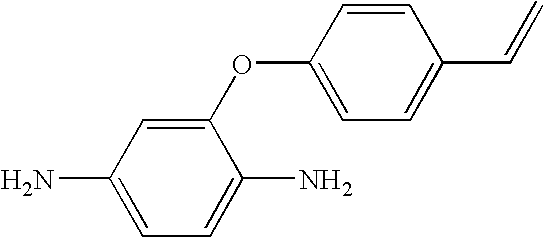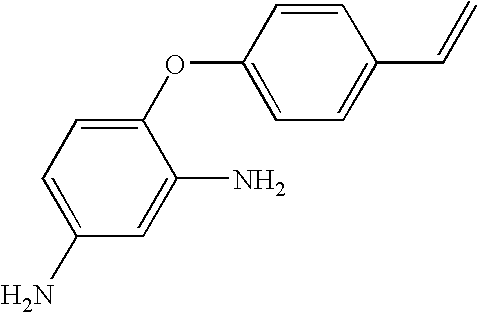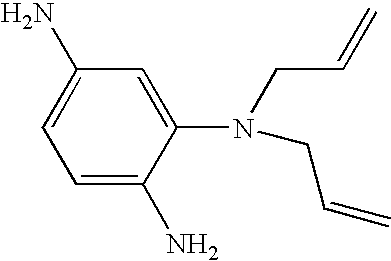Hybrid polymer materials for liquid crystal alignment layers
a hybrid polymer and alignment layer technology, applied in the field of hybrid polymer composition, can solve the problems of reducing the electrical performance and optical stability of the device, affecting the long-term stability and performance of the device, and low assembly line throughpu
- Summary
- Abstract
- Description
- Claims
- Application Information
AI Technical Summary
Benefits of technology
Problems solved by technology
Method used
Image
Examples
example 2
[0083] The following example describes the synthesis of novel Addition Monomer 2 for use in hybrid polymers of the invention.
[0084] Acetic Acid 4-iodo-phenyl Ester 20
[0085] 4-Iodophenol (25 g) and acetic anhydride (25 mL) were combined in a 250 mL Erlenmeyer flask. Pyridine (10 mL) was added carefully over 10 min. The reaction was kept at room temperature overnight, then poured into separatory funnel containing 100 mL water and extracted with ether (2.times.100 ml). The combined organics were washed with water (2.times.100 ml) and brine and then dried over MgSO.sub.4. The crude concentrate was recrystallized from hexane to give 25.5 g of acetate.
[0086] 4-Heptadecafluorooctyl-phenol 21
[0087] To a solution of acetic acid 4-iodo-phenyl ester (9 gm, 36.6 mol) in anhydrous DMSO (75 mL) was added copper powder (5.8 g, 0.091 mol), perfluorooctyl iodide (25 g, 0.046 mol) and iodine (130 mg). The reaction mixture was heated to 105.degree. C. for 18 hr, cooled, combined with 100 ml water and ...
example 3
[0090] The following example describes the synthesis of novel Addition Monomer 3 for use in hybrid polymers of the invention.
[0091] 4-(6-Hydroxy-hexyloxy)-benzaldehyde 23
[0092] 4-Hydroxybenzaldehyde (15 g, 122 mmol) was dissolved in 150 ml of NMP. 6-Chlorohexanol (20.16 gm 146 mmol), anhydrous potassium carbonate (20.36 g, 146 mmol) and a catalytic amount of potassium iodide were added. The batch was stirred at 90 C for 24 hours. Water was added to the cooled solution, which was subsequently extracted with 3.times.100 mls of ethyl acetate. The combined organics were washed with 5% KOH (2.times.100 ml s), brine solution and then dried over magnesium sulfate. The concentrated product was then recrystallized from a 1:1 mixture of ethyl acetate / hexane to give 14 gm of an off-white solid.
[0093] 3-[4-(6-Hydroxy-hexyloxy)-phenyl]-1-(4-iodo-phenyl)-propenone 24
[0094] 4-Iodoacetophenone (2.46 gm, 10 mmol) was dissolved in 20 ml toluene. 4-(6-Hydroxyhexyloxy)benzaldehyde (10 mmol, 2.22 gm), p...
example 4
[0099] The following example describes the synthesis of novel Addition Monomer 4 for use in hybrid polymers of the invention.
[0100] 2-Methyl-acrylic Acid 6-{4-[3-(2-methyl-acryloyloxy)-3-oxo-propenyl-]-phenoxy}-hexyl Ester 27
[0101] To an ice-cooled solution of 3-[4-(6-hydroxy-hexyloxy)-phenyl]-acry-lic acid (4.1 gm, 15.5 mmol), triethylamine (4.08 gm, 40 mmol) and BHT (a few crystals) in 40 ml of dichloromethane was added dropwise methacryloyl chloride (4.05 gm, 39 mmol) in 5 ml dichloromethane. The reaction mixture was allowed to react for 2 hours, at which time the dichloromethane was removed under reduced pressure. The mixture was partitioned between 1M HCl (100 ml) and ethyl acetate (75 ml) and the aqueous layer subsequently extracted twice more with 75 ml portions of ethyl acetate. The combined organic layers were washed with 100 ml portions 5% sodium hydrogen carbonate and brine and then dried with magnesium sulfate and concentrated to give 5 gm of a white solid.
[0102] 2-Methy...
PUM
| Property | Measurement | Unit |
|---|---|---|
| Volume | aaaaa | aaaaa |
| Volume | aaaaa | aaaaa |
| Volume | aaaaa | aaaaa |
Abstract
Description
Claims
Application Information
 Login to View More
Login to View More - R&D
- Intellectual Property
- Life Sciences
- Materials
- Tech Scout
- Unparalleled Data Quality
- Higher Quality Content
- 60% Fewer Hallucinations
Browse by: Latest US Patents, China's latest patents, Technical Efficacy Thesaurus, Application Domain, Technology Topic, Popular Technical Reports.
© 2025 PatSnap. All rights reserved.Legal|Privacy policy|Modern Slavery Act Transparency Statement|Sitemap|About US| Contact US: help@patsnap.com



